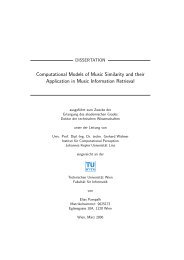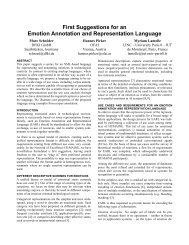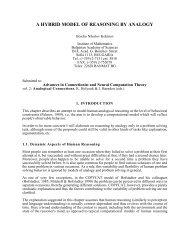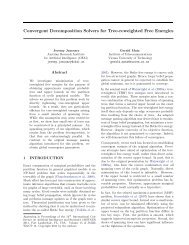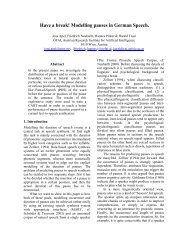Global Musical Tempo Transformations using Case Based ... - OFAI
Global Musical Tempo Transformations using Case Based ... - OFAI
Global Musical Tempo Transformations using Case Based ... - OFAI
You also want an ePaper? Increase the reach of your titles
YUMPU automatically turns print PDFs into web optimized ePapers that Google loves.
Retrieve Pick earlier solved problems from the case base, that are similar<br />
to the problem to be solved currently.<br />
Reuse Adapt (or construct) an initial solution for the current problem,<br />
based on the solutions of the retrieved problems.<br />
Revise Test the proposed solution for adequacy (typically by user feedback)<br />
and if necessary revise the solution to meet the requirements.<br />
Retain Store the problem, together with its revised solution, in the case<br />
base for future use.<br />
Figure 3.3 shows how the four CBR tasks are organized within the problem<br />
solving process. For generating a solution, a CBR system needs must at least<br />
provide methods for the Retrieve and Reuse tasks. The Revise and Retain<br />
tasks are necessary for storing proposed and corrected solutions as cases in<br />
the case base, thus enabling learning.<br />
After a subsection about the representation of cases in CBR systems,<br />
which is an implicit but very important aspect of CBR, each of the four<br />
tasks will be treated more in detail.<br />
3.3.1 <strong>Case</strong> Representation<br />
An important aspect of CBR system design is the representation of the cases.<br />
In the first place the representation of information in the cases constrains<br />
the way in which cases in the case base can be used in the various CBR<br />
tasks. A case could be as simple as a vector of attribute-value pairs comprising<br />
information about the problem and the solution (which is a common<br />
representation in Nearest Neighbor Learning, see page 30). This kind of representation<br />
is called a flat representation. In most CBR systems however, a<br />
case contains extra information in addition to the problem description and<br />
the solution, that specifies for example the dependencies of certain aspects<br />
of the solution on certain features of the problem description, or how the<br />
solution was obtained. The latter touches on another aspect of case representation,<br />
that is closely related to the methods used for the Reuse task<br />
(see section 3.3.3). That is the question whether a case should contain the<br />
outcome of the reasoning process (the solution), or rather a problem solving<br />
trace, (that is, a description of how the solution was obtained), or a combination<br />
of solution and trace. Such traces may offer hints on how the solution<br />
can be constructed for the input problem.<br />
Besides the question how the cases should be represented, an important issue<br />
is the representation/organization of the case base as a whole. Especially<br />
34




